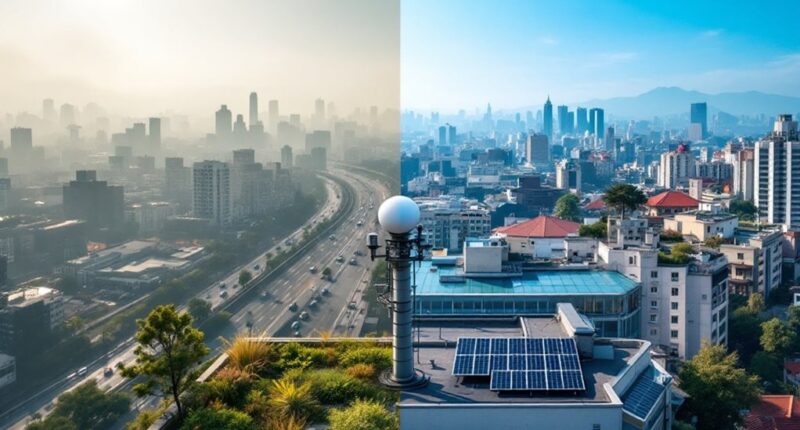Air quality reflects the mix of gases and particulates we breathe daily. Major pollutants include particulate matter (PM2.5/PM10), ozone, carbon monoxide, and sulfur dioxide, originating from vehicles, industry, power plants, and agriculture. The Air Quality Index (AQI) measures pollution on a 0-500 scale, with higher numbers indicating dangerous conditions. Continuous monitoring stations track these pollutants, while regulations and clean energy initiatives help protect public health. Your lungs will thank you for understanding what’s actually floating in that “fresh” air.

While most people give little thought to the invisible ocean of air surrounding them, the quality of that air profoundly impacts every breath we take. This gaseous mixture—our atmosphere’s cocktail of oxygen, nitrogen, and other elements—can contain various unwelcome guests in the form of pollutants that determine what scientists call “air quality.”
Think of it as nature’s restaurant review system, but instead of stars, we get the Air Quality Index (AQI)—a scale from 0 to 500 that ranges from “fresh mountain breeze” good (0-50) to “maybe don’t go outside today” hazardous (301-500). Understanding how to interpret AQI data can help individuals make informed decisions about outdoor activities and health protection measures.
The AQI: where 50 means breathe deeply, and 300 means perhaps invest in that indoor treadmill after all.
The usual suspects in this atmospheric lineup include particulate matter (the tiny troublemakers known as PM2.5 and PM10), ground-level ozone (O3)—not to be confused with its protective cousin in the upper atmosphere—plus carbon monoxide, sulfur dioxide, nitrogen dioxide, and lead. The EPA carefully monitors these five major pollutants regulated under the Clean Air Act to establish national air quality standards.
These pollutants don’t just appear by magic; they’re the byproducts of our modern existence. Vehicle emissions, industrial processes, and power plants are like that friend who never cleans up after the party, while agricultural activities and natural sources like wildfires contribute their fair share too.
The consequences of breathing poor-quality air aren’t just about that slight wheeze after your morning jog. Respiratory issues, cardiovascular problems, and worsening of existing conditions can result from long-term exposure. The World Health Organization estimates that approximately 7 million deaths occur prematurely each year worldwide due to air pollution exposure.
It’s particularly rough on vulnerable populations—the elderly, children, and those with pre-existing conditions get the VIP pass to health concerns nobody wants.
Fortunately, we’re not flying blind in this invisible battlefield. Networks of monitoring stations act like weather reporters for pollution, continuously collecting data through ground stations, satellites, mobile sensors, and even citizen science projects.
Protection measures include government-imposed emissions regulations (the environmental equivalent of a strict parent), clean energy adoption, public transportation improvements, and indoor air filtration.
Even individual actions like carpooling and energy conservation can help—proving that sometimes, the power to clear the air literally rests in our hands.
Frequently Asked Questions
How Do Indoor Plants Affect Air Quality?
Indoor plants can purify air by absorbing pollutants through leaf openings and converting them into harmless substances.
While NASA studies showed impressive results in controlled environments, real-world effectiveness is more modest.
Plants can remove formaldehyde, benzene, and toluene, but you’d need 15-18 houseplants in an average home to see benefits.
Proper maintenance is essential—overwatering can create mold problems.
Natural ventilation typically outperforms plants for air purification, making them a helpful supplement rather than a complete solution.
Can Weather Conditions Worsen Existing Air Pollution?
Weather conditions can greatly worsen existing air pollution.
Temperature inversions trap pollutants near the ground, while heat waves accelerate ozone formation. Stagnant air and low wind speeds allow pollutants to accumulate rather than disperse.
Drought conditions increase particulate matter, and high humidity can form secondary pollutants.
Even precipitation plays a role—sometimes washing away pollutants, other times creating conditions where pollutants get trapped in fog or mist near ground level.
Does Traffic Time Affect My Exposure to Air Pollutants?
Traffic time greatly affects exposure to air pollutants. During rush hours, stop-and-go traffic creates pollution hotspots where drivers inhale higher concentrations of PM2.5 and ozone.
The longer someone sits in traffic, the greater their cumulative exposure. Following heavy-duty vehicles or tailgating increases this risk considerably.
Even vehicle choices matter – keeping windows closed and using high-efficiency cabin filters can reduce particle exposure by up to 90%, turning that congested commute into a slightly less toxic experience.
How Accurate Are Personal Air Quality Monitoring Devices?
Personal air quality monitoring devices offer reasonable accuracy, typically within ±10-20% for PM2.5 and ±25% for VOCs compared to reference instruments.
Studies show correlation values ranging from 0.60 to 0.88 with professional equipment. While not meeting regulatory standards, these devices excel at identifying trends and short-term forecasts.
Accuracy varies by manufacturer and is affected by placement, humidity, and temperature. For everyday decision-making about air quality, their precision is generally sufficient.
What Air Purifier Technology Is Most Effective for Allergies?
HEPA filtration technology stands out as the most effective solution for allergy sufferers.
These filters capture 99.97% of particles as small as 0.3 microns, including common allergens like pollen, dust mites, and pet dander.
Allergists consistently recommend HEPA filters for their proven effectiveness.
For enhanced results, combining HEPA with activated carbon filters addresses both particulate allergens and chemical irritants that might trigger allergic responses, creating a more thorough air cleaning system.









